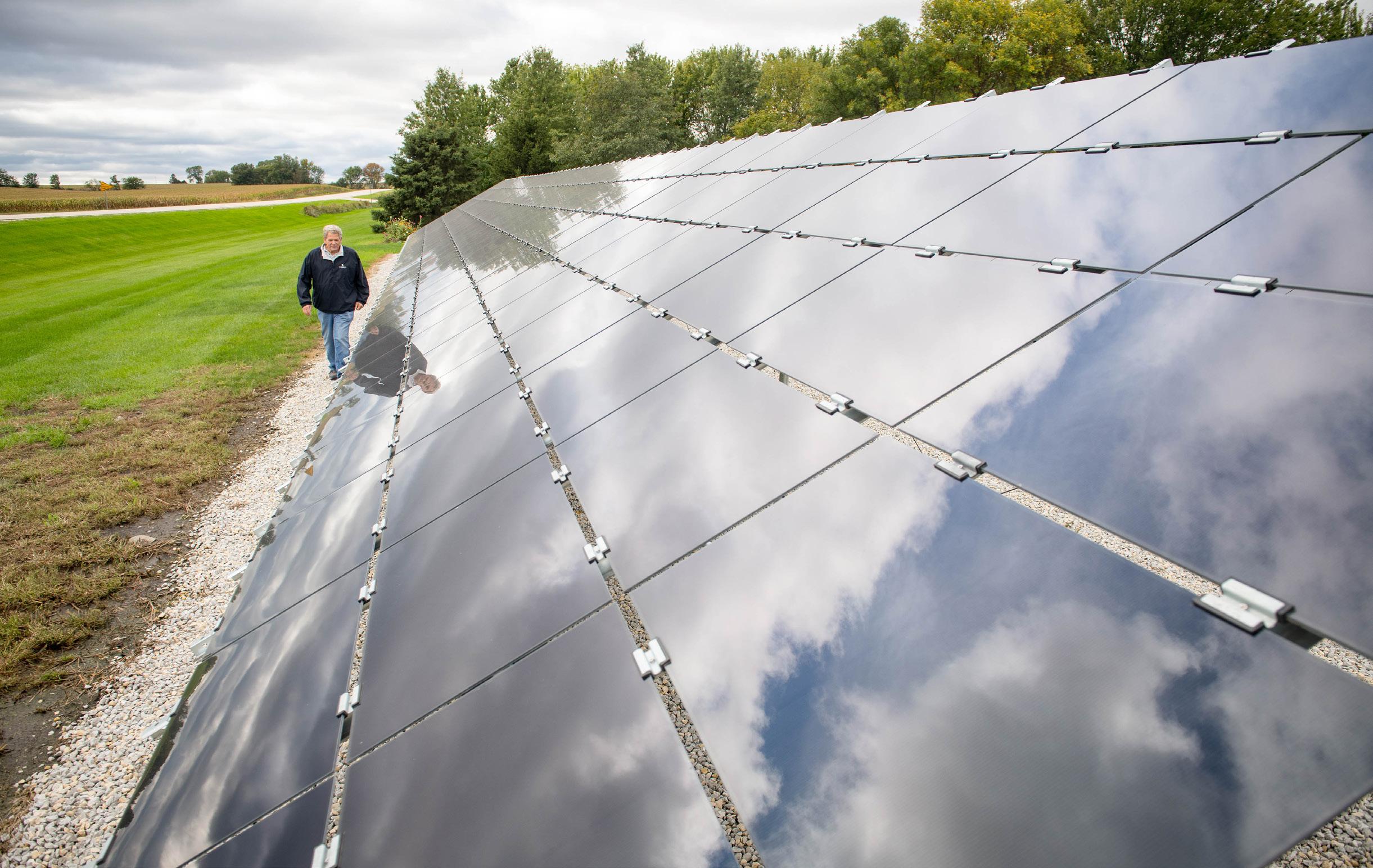
3 minute read
Farming Renewably
Above: Earlier this year Rick Juchems built on his conservation philosophy by installing a solar panel array at his farm near Plainfield.
Considering electricity as an input
BY JOSEPH L. MURPHY
Farmers know commodities. Planting soybeans, corn and other crops are the mechanisms for sustaining their operations. More and more, farmers are adding renewable energy to the list of commodities they farm.
Rick Juchems, Iowa Soybean Association (ISA) District 3 Director from Plainfield, recently incorporated renewable energy into his farm by installing solar panels. The installation was the culmination of 10 years of research that is now allowing him to farm the sun while adding money back into his pocket.
“I always want to conserve,” Juchems says. “Conserve our soil, our water and other natural resources. I thought solar panels would be a good way to add to that philosophy.”
Photovoltaic (PV) solar panels are made of many individual solar cells. The cells are made of silicon and act like semiconductors found in computers. They are constructed with a positive layer and a negative layer, which together create an electric field, just like a battery.
Juchems installed three 120-feet long solar arrays in June. There are 540 individual solar panels in the array. They produce 63 kilowatts of direct current (DC). That energy is 42 kilowatts of alternating current (AC). The electricity produced powers his farm and the excess energy is to MidAmerican Energy, which is his power supplier. Juchems then recieves a credit on his power bill.
“Most of the time we are using all of the energy produced, especially in the winter when we are running the fans and aeration for the hogs,” Juchems says. “During the summer, pit fans are running and the circulation fans are running. It takes a lot of electricity to power the farm.”
Juchems used state and federal tax incentives to defray the cost of the solar array. He also applied for a federal energy grant.
“We had a $10.70 monthly energy bill when we turned it on in August,” he says. “Before the solar panels our electric bill averaged $600 to $700 monthly.”

Rick Juchems, farmer from Plainfield
Derek Sadler, a co-owner of Current Renewable Efficiencies (CRE), says farmers plan for input costs as they prepare for planting. Inputs like fungicide and fertilizer can be cut to save costs, but one input that is a constant for farming operations is electricity.
“We view electricity as another input," Sadler says, referring to the energy costs of running a farm.
National electric rates increase an average of 4% per year. He says farmers can capitalize on that by using renewable energy.
“It’s almost like buying a propane contract for the next seven years, or whatever the payback is, and once you finish the contract the propane is free,” Sadler says. “You’re paying the chunk up front, and you’re waiting to get all your money back. Once you do, your returns keep happening. The equipment could go for a very long time."
CRE in Shell Rock has been supplying the hardware, engineering, analysis and installation of renewable energy for agriculture, commercial and private clients across Iowa for 10 years. About 80% of their business comes from the agriculture sector and much of that is comprised of livestock farms.
“A lot of these farmers are looking beyond themselves,” he says. “They are looking to the next generation that is going to take over the operation. It is a way to take that expense away for them."

Sadler says as the technology improves it will translate into more savings. He believes more watts will be generated per panel in the future. That will translate to cheaper installation costs. Improving battery technology could also be a gamechanger for solar users.
“Farmers will be able to market their energy,” he says. “It will allow you to be more specific on how you manage your energy. If you are over producing you can store it in your battery instead of selling it for two cents."
Marketing energy, just like marketing grain, gives the seller better decision making power when it comes to selling energy produced on the farm. Selling at optimal times and being able to store when needed, will allow the producer to build a marketing strategy that can pay more, according to Sadler.
“The only drawback I have found is that the solar panels take up more space,” Juchems says.
Contact Joseph Murphy at jmurphy @iasoybeans.com








